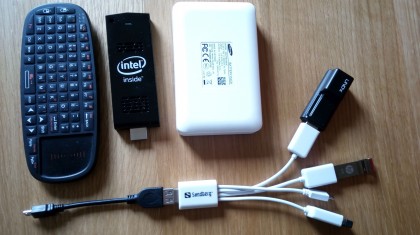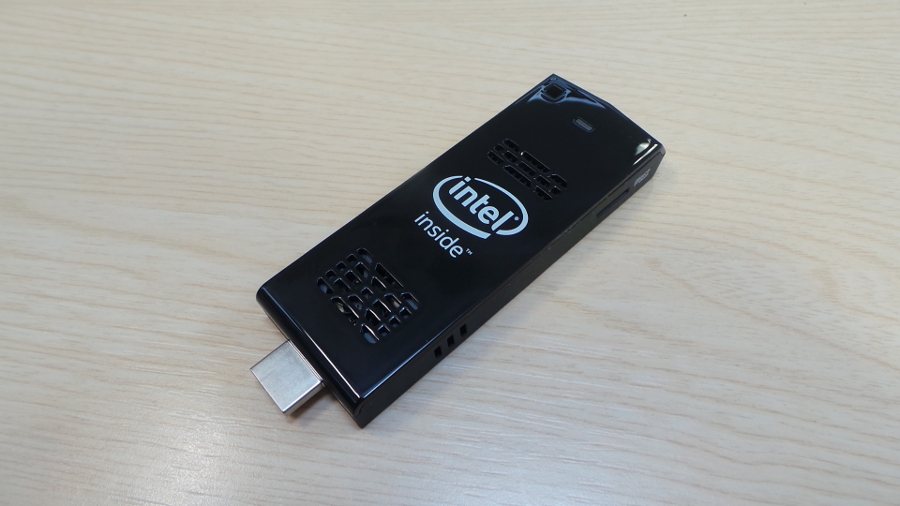Why you can trust TechRadar
The Compute Stick is an important step for Intel, more in terms of the symbolism rather than the actual technology. This is, after all, tech that we've seen elsewhere and it has just been repackaged in a different form factor. For the first time ever, Intel could end up competing in the consumer market with its very own customers.
We liked
I applaud Intel's decision to launch what is a bold product. It is yet another avenue for its Atom range and although the company is nearly two years late compared to the ARMDroid players, better late than never. As an enthusiast, I like the ability to tinker with the BIOS, something that fewer Windows-based devices allow these days. It is also one of the smallest x86 computers around, and with a couple of accessories (see below) it can become a near autonomous, on-the-go, fully-fledged office.

We disliked
The dongle form factor was always going to be a compromise. The HDMI port is a fragile one and to get anything to dangle from it is asking for trouble. This is especially true if the HDMI ports on the client display do not face the floor.
There's also the issue of powering the device – current HDMI technology cannot power devices yet which means that you need to secure an additional power socket to provide juice to the Compute Stick.
That brings in a fair amount of issues especially when used in a commercial environment as suggested by Intel. I don't understand why Intel went for an active cooling system when almost all solutions based on the Z3735F on the market run passively. Adding a fan increases noise, uses power and adds another point of failure (they gather dust).
I am also puzzled by the fairly narrow operating temperature (from freezing point to 35 degrees Celsius). That is going to be reached rapidly if the device is tucked behind a plasma display, in a window, on a hot sunny day. What happens beyond 35 degrees? Will the fan go into overdrive? Will the CPU throttling kick in?
And there's the issue of the price, too. You can get the Linx 7 from Amazon for as little as £65, half the price of the Compute Stick (a version with 2GB of RAM costs only $100 in the US). You get a much more versatile solution (cameras, battery etc) plus a one-year subscription to Office 365 included.
True, it is bigger and has only 1GB of RAM, but this shows how intense competition is out there. If size is not an issue, then for a bit extra – £30 – you can get the Lenovo Thinkstation E50, which is a small but fully-fledged computer with nearly three times the performance of the Compute Stick.
Final verdict
The bulk of my criticisms are aimed at the form factor and not the hardware. Intel has been very clear as to what to expect from this mature, tried-and-trusted hardware combination. Windows 8.1 performs decently on this Bay Trail-based solution and Windows 10 on Cherry Trail is likely to improve things even more.
But unless the company plans for something else, I can't see Intel succeed with this form factor. This actually has nothing to do with Intel and it's more about how Microsoft sells Windows 8.1 at the moment – because vendors can get the OS for free by bundling a display with their PC.
That's why we're seeing products like the Pipo X8 which is essentially a tablet without a camera or battery, but which retails for less than a similar screen-less computer. For most people, the additional display, a year's worth of Office 365 Personal and a few other goodies (like more ports) will prove to be alluring enough.
For those use cases that require a small footprint, maybe Intel should consider designing a PC that integrates with an HDMI cable and is powered via the monitor's own socket. Or they could come up with a solution similar to Marvell's Sheevaplug with a long HDMI cable, maybe one that could include Powerline technology.
At the end of the day, the Compute Stick is very much a first-generation product that sits between two markets, consumer and business. It is going to face some serious competition in the former, while the latter may well sneer at the device because of its intrinsic lack of ruggedness.
Bring in Cherry Trail, change the design and cut down the price and Intel might have a fighting chance in an already crowded market. Hopefully, the Compute Stick will prove to be a catalyst for the x86 ecosystem, one that will force it to innovate or face obsolescence in the hands of its creator.

Désiré has been musing and writing about technology during a career spanning four decades. He dabbled in website builders and web hosting when DHTML and frames were in vogue and started narrating about the impact of technology on society just before the start of the Y2K hysteria at the turn of the last millennium.
